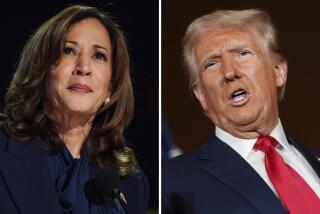House and Senate Negotiators Vote Sweeping Tax Bill : Individual Maximum Rate Cut From 50% to 28%; Passage Seen Next Month
- Share via
WASHINGTON — Congressional tax negotiators late Saturday night formally approved a sweeping bill to eliminate many income tax breaks and slash the maximum personal tax rate from 50% to 28% for most individuals.
“They said out there it couldn’t be done,” House Ways and Means Committee Chairman Dan Rostenkowski (D-Ill.) proclaimed after the vote. “Well, we’ve done it.
For the record:
12:00 a.m. Aug. 18, 1986 For the Record
Los Angeles Times Monday August 18, 1986 Home Edition Part 1 Page 2 Column 1 National Desk 1 inches; 30 words Type of Material: Correction
The Times incorrectly reported Sunday that the income tax deduction would be retained for charitable contributions made by taxpayers who do not file itemized returns. It would be abolished in 1987 and thereafter.
“We’ll put our names to a new tax system that brings a new sense of justice in the way we tax income and a new sense of confidence to those who will have to pay,” Rostenkowski added.
Approval came on a voice vote at 11:15 p.m. after Senate and House tax writers had approved the plan in separate, closed sessions. Senate negotiators voted 8 to 2 for approval. The Democrats who controlled the House team promptly followed suit.
Agreement by the tax negotiators cleared the way for the full House and Senate to give their final approval to the historic bill soon after they return on Sept. 8 from their summer recess and send it to President Reagan to sign it into law.
Until the final night, the fate of tax revision, which had been declared dead many times over the past year, remained up in the air. The tax negotiators reached their agreement--a compromise between a bill passed by the House last year and the Senate earlier this year--only after overcoming some 11th-hour snags in a package prepared early Saturday morning by Rostenkowski and Senate Finance Committee Chairman Bob Packwood (R-Ore.).
Packwood, opening the formal ceremony Saturday night, said: “I’m thankful for Danny (Rostenkowski), proud of the Congress, and happy for the nation.”
Enactment of the bill would spell a tax cut for most individuals on their earnings in 1988, when almost all provisions of the new tax code would be fully effective. The average tax cut for that year would be 6.1% compared with taxes under current law, with lower- and middle-income taxpayers receiving the largest percentage reductions.
Some taxpayers would fare less well next year, however, because tax breaks would be eliminated as of the first of the year but the rate cuts would not be as deep as those that are scheduled to take effect in 1988.
For 1987 only, there would be five tax brackets with tax rates starting at 11%. The top individual rate would be 38.5%, on taxable income above $90,000 for couples and $54,000 for singles.
The average tax cut in 1987 would be only 1.6%. Taxpayers earning more than $75,000 would, on average, experience a tax increase next year, with those in the $200,000-and-up bracket being socked by an average tax hike of 11.4%.
Despite that, congressional tax experts said fully 81.3% of all taxpayers would pay less in 1987 income taxes under the new tax code than under current law.
Corporate Tax Boost
Altogether, the tax bill would cut personal tax payments by $121.7 billion through 1991 and boost corporate and other taxes by $121.9 billion, according to congressional tax analysts.
But the final package also contains revenue swings that could add to the federal government’s budget problems.
The plan would increase government revenues an estimated $11 billion above current law next year but would lose $17 billion in 1988 and another $15 billion in 1989. In 1990 and 1991, according to revenue projections prepared by congressional tax analysts, it would pick up $9 billion and $12 billion.
For corporations, the bill would slash the maximum tax rate to 34%, a sharp decrease from today’s 46% but one percentage point greater than the maximum rate in the Senate-passed bill. But the reduction in the maximum tax rate for many industries from 46% to 34% would be more than offset by the elimination of a host of valuable tax breaks.
Investment Tax Credit
Most significantly, the investment tax credit would be wiped out retroactively to last Jan. 1. That tax break, of particular importance to heavy industry, allows businesses a tax credit of up to 10% of the cost of investment in new plants and equipment.
Current tax write-offs to offset the depreciation of the value of plants and equipment, which were made much more generous in 1981, would be largely retained. The one exception would be investments in real estate, which would become much less attractive from a tax point of view.
Investors would be adversely affected by the elimination of the tax preference for capital gains--profits from the sale of investments held at least six months. They would be taxed as ordinary income, for a maximum effective tax rate of 28% in 1987 and 33% beginning in 1988. Current law excludes 60% of capital gains from taxation, leaving an effective maximum rate of 20%.
Many of the tax negotiators’ final decisions reached politically sensitive areas of the personal tax code. The tax writers decided to abolish the deduction for state and local sales tax payments, although state and local income and property taxes would still be deductible. Senate negotiators agreed not to press to restore the sales tax deduction for taxpayers living in states without income taxes in return for a promise by the House team not to crack down harder on a special tax break for defense contractors.
The final adjustments became necessary when some negotiators initially balked at parts of the agreement worked out early Saturday morning by Packwood and Rostenkowski.
Multitude of Problems
Part of the 11-member House tax-writing team complained that the bill would not provide enough tax relief to enough taxpayers. Some Senate negotiators, reluctant to go along with the deal until they could study the fine print of the 99-page document, found a multitude of tiny problems affecting interests in their states.
The tax teams tinkered with the package throughout the day. After a series of minor adjustments, Rostenkowski told reporters: “It’s looking much better. There’s every indication we’ll be able to sell the rates and distribution.”
Ostensibly, all personal taxable income beginning in 1988 would be taxed at one of only two rates--15% for the first $29,750 in income for couples and 28% for the rest of their income.
But some relatively affluent taxpayers would face a top rate of 33% because of a wrinkle in the bill that would phase out the benefit of the 15% rate beginning at a taxable income of $71,900 for couples. For those couples some of their first $29,750 in income would be taxed at 28% instead of 15%.
Tax Rate for Singles
For singles, the benefit of the 15% tax rate would be phased out for taxpayers earning more than $43,140.
Some House negotiators pushed for a 29% top tax rate to gain revenue lost by granting some additional tax benefits for taxpayers below the top income levels. But the Senate team held the line at 28%.
Besides slashing tax rates, the final bill would substantially boost the personal exemption for taxpayers and their dependents--but not as quickly as provided in either the House-passed or the Senate-passed bill.
Personal Exemption
In one of their last-minute decisions, the tax negotiators determined that the personal exemption, currently $1,080, would rise to $1,900 next year and $1,950 in 1988 before finally reaching the target of $2,000 in 1989. After that, it would rise with inflation. For very high-income taxpayers, however, the personal exemption would be reduced or eliminated.
The tax writers also accepted a huge jump in the standard deduction, in effect cutting the tax burden for the low- and middle-income taxpayers who typically elect not to itemize deductions. The standard deduction would rise from the current $3,670 to $5,000 for couples and from $2,480 to $3,000 for singles.
As approved by the Senate negotiators, the bill would concentrate its greatest tax breaks in percentage terms on lower-income taxpayers.
The average 1988 tax cut for taxpayers with taxable incomes between $20,000 and $30,000, for example, was estimated at 9.8%. By contrast, taxpayers earning between $50,000 and $75,000 would enjoy an average tax reduction of only 1.7%, and those earning more than $200,000 would receive a 2.3% cut.
Politically Sensitive
Negotiators did not tamper with the agreement between Packwood and Rostenkowski on individual retirement accounts.
On that politically sensitive issue, taxpayers filing joint returns with taxable earnings of less than $40,000 ($25,000 for singles) could continue to make deductible IRA contributions of up to $2,000 for workers and $2,250 for non-working spouses. So could all taxpayers not covered by pension plans at work.
More affluent taxpayers covered by pension plans would lose some of their tax benefit. The deductible contribution would be phased out for people with taxable incomes between $40,000 and $50,000 ($25,000 and $35,000 for singles) and eliminated beyond those income levels. Those taxpayers could continue contributing to IRAs, however, and the earnings would still be tax-deferred.
Limit on 401(k) Plans
An individual’s tax-free contributions to employer-based 401(k) retirement savings plans would be limited to $7,000, down from $30,000 under current law.
The bill would also eliminate or reduce several other popular deductions, such as those for consumer interest and medical expenses. Non-itemizers, however, could continue to claim a deduction for charitable contributions.
The tax agreement makes a nominal attempt to close a loophole created in earlier versions of the bill in which the deduction for consumer interest payments was eliminated but deductions for most home-related borrowing--second mortgages as well as first mortgages--continued. In the final bill homeowners would be allowed a deduction for borrowing against the value of their first and second homes only up to an amount equal to the original purchase price plus an additional allowance for home improvements, unusual medical expenses and family educational costs. In practical terms, it seems unlikely to deter substantial home equity borrowing for consumer goods.
Tax Shelters Dismantled
The plan, largely by boosting the personal exemption and standard deduction, would take 6 million of the poor off the tax rolls. For taxpayers at the other end of the income scale, it would shut down most real estate tax shelters, which provide boons to some high-income people.
The plan was written entirely in closed meetings during the past several weeks, with most of the provisions forged by Packwood and Rostenkowski meeting with top staff members--but no other members of Congress--at their sides.
When tax bargainers finally moved into open session Saturday night, a handful of lawmakers temporarily held up the ceremonial approval of the bill. They vigorously objected to the demand by their committee chairmen that they hastily ratify the agreement without having time to study it.
‘Carte Blanche’ Given
Sen. John C. Danforth (R-Mo.), pointing out that the conferees had “given carte blanche” to Packwood and Rostenkowski to put together a package, argued that the “least we can expect is to see what we’re doing before we do it.”
He also contended that some of the concessions Packwood made to Rostenkowski would undermine economic growth by boosting taxes on businesses.
“This is a House bill,” he argued. “When you cross a fair maiden--which is the Senate bill--with a gorilla, the result is still a gorilla.”
The hundreds of lobbyists gathered for the occasion, many of whom have been fighting a rear-guard action for more than a year in an effort to stop the tax revision steamroller, broke into loud applause after Danforth’s speech.
Private Sessions
But Rep. Richard A. Gephardt (D-Mo.), defending the way the tax bill was written, pointed out that all 22 House and Senate tax negotiators met futilely in a variety of private sessions for nearly a month in an effort to thrash out the differences between the two versions of tax revision. If the negotiators failed to ratify the agreement reached by their chairmen and instead returned to the issue after Congress goes back to work on Sept. 8, he argued, lobbyists for special interests would have a last chance to defeat the measure.
“To hold the vote open on basic decisions,” he said, “would defeat our purpose.”
As tax negotiators entered the home stretch, their progress satisfied President Reagan, who must ultimately sign the bill that Congress sends to him. Reagan was briefed on the negotiations as he left the White House on Saturday for a California vacation.
In a statement from his Santa Barbara ranch, Reagan said: “Although we have not seen all the details of the final agreement adopted by the conferees, I believe that this agreement satisfies my requirements for meaningful tax reform. The agreement significantly reduces tax rates and simplifies the tax code for all Americans while at the same time eliminating unnecessary loopholes. In short, it’s good for the economy and good for the taxpayer.”
President spokesman Larry Speakes, asked about the decision to set the top individual tax rate at 28% and the top corporate rate at 34%, in each case one percentage point above the rates approved in the Senate-passed tax bill, said: “I don’t think that’s a major problem for us.”
The toughest fights in the tax negotiations broke out over the issue of corporate tax breaks. Originally, the House proposed to boost corporate income taxes by about $178 billion over a six-year period, while the Senate bill would have raised corporate taxes by $93 billion. Senate tax negotiators vigorously defended a host of tax breaks for particular industries.
Two Sides Compromised
The two sides compromised on a number of industry-targeted provisions. They agreed to only a modest trimming of tax breaks for the timber industry, which is essential to Packwood’s home state of Oregon. They scaled back special tax treatment of oil and gas firms by about $600 million more over five years than the Senate bill had offered.
The Reagan Administration and Federal Reserve Chairman Paul A. Volcker, jumping into the fight over tax breaks for the banking industry, managed to convince both sides that the elimination of a valuable tax deduction to cover future bad debts should be postponed for so-called “troubled” banks that might be financially weakened by the change.
The two sides compromised over an issue that plagued the conference by agreeing to follow the Senate’s formula for applying a stiff minimum tax on corporations for the next three years, but then shifting to a House-recommended approach in later years.
On business write-offs for investment in plant and equipment, the panel largely adopted the Senate’s system of accelerated depreciation but scaled it back modestly to produce an additional $13 billion in revenues over the next five years.
Accounting Provisions
The plan also includes a number of accounting provisions that would substantially increase taxes on business. New rules would require companies to stretch out inventory costs and curtail the use of the installment-sales method for deferring taxes.
Another major brouhaha arose over tax-exempt bonds, with the House pressing to limit all private-purpose bonds under statewide volume caps that would limit the amount of tax-free bonds that could be issued for such purposes as housing, industrial development and non-profit organizations including universities and hospitals. The Senate team successfully insisted on exempting non-profit groups from the caps, but was forced to accept even more stringent limitations on other private purpose bonds.
The bill also makes a number of sweeping changes in retirement policy. It orders corporations to begin “vesting” employees with pensions after only five years instead of 10 and requires firms to provide at least a modest pension to all their workers who qualify, including lower-income retirees who might be ineligible currently because of their Social Security income.
WINNERS (AND LOSERS) FROM THE TAX BILL
(Average percentage decrease or increase in tax bills for taxpayers in various income categories, compared with tax bills under current law.)
Income 1987 1988 Less than $10,000 -55.2% -65.7% $10,000-20,000 -16.4 -22.3 $20,000-30,000 -10.7 -9.8 $30,000-40,000 -9.4 -7.7 $40,000-50,000 -9.7 -9.1 $50,000-75,000 -0.7 -1.7 $75,000-100,000 +5.2 -1.0 $100,000-200,000 +5.6 -2.4 $200,000 and above 11.4 -2.3 Total -1.6 -6.1
Source: Congressional Joint Tax Committee
More to Read
Get the L.A. Times Politics newsletter
Deeply reported insights into legislation, politics and policy from Sacramento, Washington and beyond. In your inbox twice per week.
You may occasionally receive promotional content from the Los Angeles Times.










